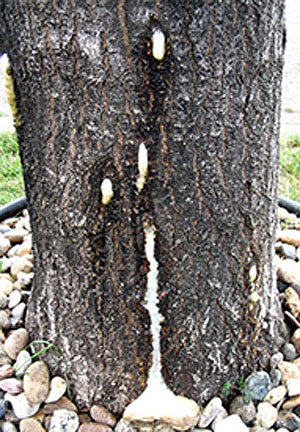

Slime flux (wetwood) is a bacterial fermentation of tree tissue, resulting in the disagreeable odor associated with this problem. In the latter case, the slime runs down the bark, discoloring plant tissues and resulting in a build-up of dry scum. In other cases, as with elm and cottonwood, infection results in wet gray to brown areas on limbs and trunk. In some trees, particularly willow, this disease results in a white to gray foam that bubbles out from under the bark. Appl Geochem 63:366–379īodí MB, Martin DA, Balfour VN, Santin C, Doerr SH, Pereira P, Cerdà A, Mataix-Solera J (2014) Wild land fire ash: production, composition and eco-hydro-geomorphic effects.Slime flux, often called bacterial wet-wood, is a bacterial disease found in many different types of trees. Geochim Cosmochim Acta 57:3855–3865īoch R, Dietzel M, Reichl P, Leis A, Baldermann A, Mittermayr F, Pölt P (2015) Rapid ikaite (CaCO 3.6H 2O) crystallization in a man-made river bed: hydrogeochemical monitoring of a rarely documented mineral formation. J Geol 101:21–33īischoff JL, Stine S, Rosenbauer RJ, Fitzpatrick JA, Stafford TW Jr (1993) Ikaite precipitation by mixing of shoreline springs and lake water, Mono Lake, California, USA. 6H 2O) from 0 to 25 ☌: environmental and paleoclimatic implications for thinolite tufa.Sediment Geol 185:131–145īischoff JL, Fitzpatrick JA, Rosenbauer RJ (1993) The solubility and stabilization of ikaite (CaCO 3 The Author(s), under exclusive licence to Springer-Verlag GmbH Germany, part of Springer Nature.īaumgartner LK, Reid RP, Dupraz C, Decho AW, Buckley DH, Spear JR, Przekop KM, Visscher PT (2006) Sulfate reducing bacteria in microbial mats: changing paradigms, new discoveries. The ikaite, and associated mineralization within and around the slime flux jelly, illustrates a new, and likely, global form of bio-mediated mineralization.Īlpha sulfur Bacteria Biomineralization Ikaite Slime flux Wetwood. The ikaite is temperature sensitive, though the laboratory results show that it can persist for several days at room temperature in the sulfur-rich jelly. This water chemistry favors the precipitation of ikaite/monohydrocalcite, both within and below the jelly. Water oozing from the wetwood is modestly alkaline (pH = 8.34), with elevated concentrations of K + (5554.7 ppm) and S as SO 4 2- (1662.9 ppm), with Ca 2+ (151.9 ppm) and Mg 2+ (270.3 ppm). fremontii wetwood is capped and surrounded by a hard mineralized zone dominated by ikaite/monohydrocalcite, alpha sulfur, and a range of carbonates and sulfates, on which the slime flux jelly occurs. Each tree wound occurs as an island of mineralization: all the elements for the mineral formation are supplied through the xylem sap expressed from the wetwood infection. Ikaite, along with alpha sulfur, precipitates in and on the bacterial slime flux jelly. The tree wound consists of infected wood, called wetwood that exudes a nutrient-rich water on which a jelly-like slime flux forms. Here is described the serendipitous discovery of ikaite on a tree (Populus fremontii) wound from the hot Sonoran Desert, which precipitates during short cold periods in the winter, whereas monohydrocalcite forms through most of the year.

Ikaite is the calcium carbonate hexahydrate (CaCO 3♶H 2O), which precipitates below ~ 7 ☌, first identified from Ikka Fjord in southwest Greenland and subsequently more widely reported.


 0 kommentar(er)
0 kommentar(er)
